PHANTOM 4 PRO - Visionary Intelligence. Elevated Imagination

An updated camera is equipped with a 1-inch 20-megapixel sensor capable of shooting 4K/60fps video and Burst Mode stills at 14 fps.The adoption of titanium alloy and magnesium alloy construction increases the rigidity of the airframe and reduces weight, making thePhantom 4 Pro similar in weight to the Phantom 4. The FlightAutonomy system adds dual rear vision sensors and infrared sensing systems for a total of 5-direction of obstacle sensing and 4-direction of obstacle avoidance.
CAMERA WITH 1-INCH 20MP SENSOR

The onboard camera has been redesigned to use a 1-inch 20-megapixel CMOS sensor. A custom engineered lens made up of eight elements arranged in seven groups, it is the first DJI camera to use a mechanical shutter, eliminating rolling shutter distortion which can occur when taking images of fast-moving subjects or when flying at high speed. In effect, it is as powerful as many traditional ground cameras. More powerful video processing supports H.264 4K videos at 60fps or H.265 4K at 30fps, both with a 100Mbps bitrate. Advanced sensors and processors ensure everything is captured with more image detail and the image data needed for advanced post-production.
The Phantom 4 Pro's camera system improves upon everything that made the original Phantom 4 so iconic. Every aspect has been significantly upgraded, including the sensor size, resolution, and image processing system, making it the most powerful Phantom to date. Users can also adjust aperture from f2.8-11 for more versatile imaging.
1-INCH 20-MEGAPIXEL CMOS
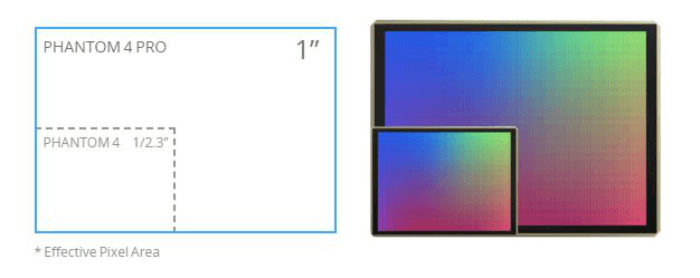

Sensor size is more important to image quality than the number of pixels because a larger sensor captures more information in every pixel, improving dynamic range, signal-to-noise ratio, and low light performance. The 1-inch 20-megapixel CMOS sensor in the Phantom 4 Pro is almost four times the size of the Phantom 4's 1/2.3in sensor. It uses larger pixels and has a maximum ISO of 12800 as well as increased contrast. It is good enough for images to be used immediately, while also capturing enough detail for advanced post-processing.
IMAGE COMPARISONS

PRODUCTION OPTIMIZED 4K

An enhanced video processing system allows video to be captured in cinema and production optimized DCI 4K/60 (4096 x 2160/60fps) at a bitrate of 100Mbps, enabling you to get high-resolution slow-motion shots. The Phantom 4 Pro also supports the H.265 video codec (Maximum resolution 4096X2160/30fps). For a given bitrate, H.265 doubles the amount of image processing as H.264, resulting in significantly enhanced image quality. Record in the high dynamic range D-log mode to make the most of this image data for color grading.
HIGH-RESOLUTION LENS
The resolution and contrast of a lens is critical to image quality because only a quality lens can capture sharp, vivid photos at high resolutions. The brand new Phantom 4 Pro camera has an aerial optimized F2.8 wide-angle lens with a 24mm equivalent focal length. It features eight elements – 2 aspherical – arranged in seven groups that fit into a smaller, more compact frame. Its images are consistently detailed with low distortion and low dispersion, ensuring that photos and videos are sharp and vivid. For the first time ever with a DJI camera, MTF (Modulation Transfer Function) results have been made public, so people can get a better understanding of lens performance.

* An MTF chart is used to measure the ability of a lens to reproduce contrast and resolve details. Low spatial frequencies reflect overall contrast, and high spatial frequencies reflect detail resolution. Both are measured in lp/mm. Image Height indicates the distance of a given point on the lens from the center of the sensor. MTF 100% indicates perfect performance.


CAPTURE EVERY MOMENT
Aerial imaging is not only used to capture landscapes; it brings new perspectives to everything from action scenes to motor racing. Capturing objects moving at high speed has always been a challenge for flying cameras using an electronic shutter. This is why the Phantom 4 Pro is the first DJI Phantom to use a mechanical shutter and a large-aperture prime lens. A mechanical shutter with a max speed of 1/2000s eliminates rolling shutter distortion which can occur when taking images of fast moving subjects or when flying at high speed. The electronic shutter has also been improved with a max shutter speed of 1/8000 seconds, and a new Burst Mode shoot capable of shooting 14 fps at 20 megapixels to catch the perfect moment.

5-DIRECTION OF OBSTACLE SENSING
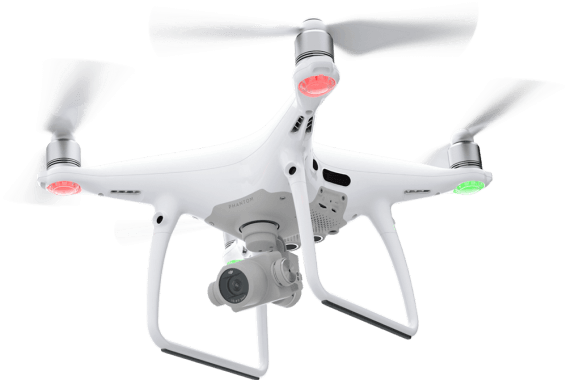
Flight Autonomy is expanded with an additional set of high-resolution stereo vision sensors placed at the rear in addition to the pair placed at the front as well as infrared sensing systems placed on the left and right sides. This network creates a total of 5-direction of obstacle sensing and 4-direction of obstacle avoidance, protecting the Phantom 4 Pro from more obstacles and giving filmmakers the confidence to capture more complex images.
6-CAMERA NAVIGATION SYSTEM
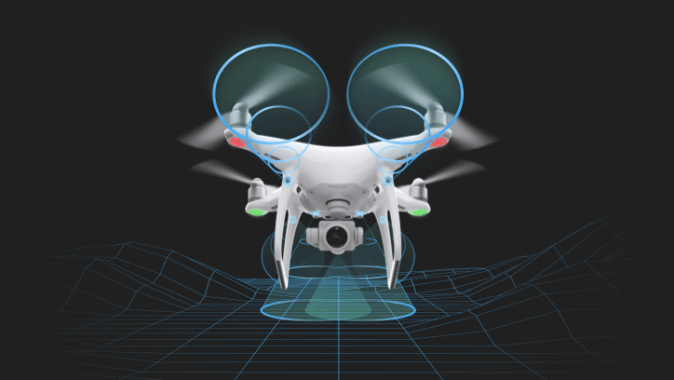
Three sets of dual vision sensors form a 6-camera navigation system that works constantly to calculate the relative speed and distance between the aircraft and an object. Using this network of forward, rearward and downward vision sensors, the Phantom 4 Pro is able to hover precisely in places without GPS when taking off indoors, or on balconies, or even when flying through windows with minimal pilot control. In the unlikely event that front and downward sensors are unable to operate, the aircraft can still hover in place using the rear stereo vision system. The Phantom 4 Pro also is able to fly in complex environments at a flight speed of up to 31mph (50kph) while avoiding obstacles in its path. In Narrow Sensing Mode, the Phantom 4 Pro narrows its sensing scope enabling it to see in more detail and fly through small spaces.
WHAT IS FLIGHTAUTONOMY
FlightAutonomy is an advanced aerial intelligence and flight automation platform. It is made up of a complex network of ten component groups including seven cameras — forward, rearward and downward dual vision sensors and the primary camera — an infrared sensing system, dual-band satellite positioning (GPS and GLONASS), two downward facing ultrasonic rangefinders, redundant IMUs and compasses, and a group of powerful, specialized computing cores. The Phantom 4 Pro acquires a real-time view of its environment and information about the height and position of nearby obstacles to create a 3D map it can locate itself within. The IMU and compasses collect crucial flight status, speed and direction data, while redundant IMUs and compasses monitor critical data and rule out possible errors, dramatically enhancing the reliability of flight.
INFRARED SENSING SYSTEM
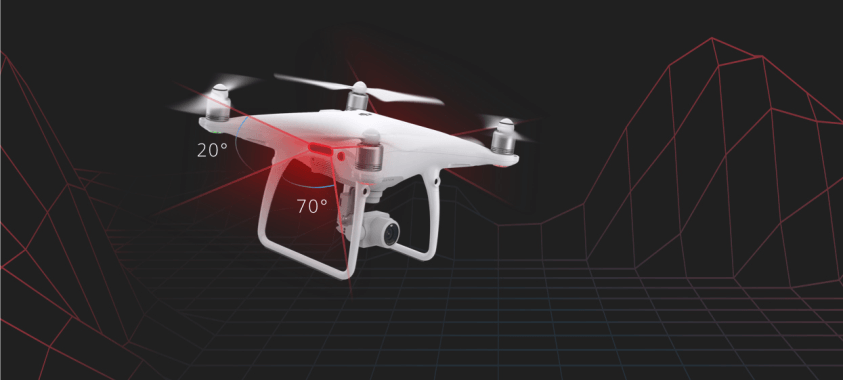
The Phantom 4 Pro is the first DJI aircraft to use an infrared sensing system. Placed on the left, and right sides of the aircraft, these measure the distance between the aircraft and any obstacles using infrared 3D scanning. When in Beginner Mode and Tripod Mode, these sensors have a horizontal field of view of 70° and a vertical field of view of 20°, providing a wide view of the scene to the sides of the Phantom, and a maximum range of 23ft (7m). Traditional ultrasonic sensors only have a detection range of 3-5m and may be confused when affected by propeller vibration. The infrared sensing system is able to sense larger areas and measure the distance between the aircraft, identifying the closest objects accurately while avoiding interference, providing more reliable sensing and protection.
REMOTE CONTROLLER WITH BUILT-IN SCREEN

A 5.5in 1080p screen integrated with the Phantom 4 Pro + offers 1000 cd/m2 of brightness, more than twice as bright as conventional smart devices.As the DJI GO app is built into the screen, hardware and software can be fully optimized, allowing you to edit and share instantly. A five-hour battery life makes the Phantom 4 Pro + a complete aerial imaging solution. The integrated upgraded Lightbridge HD video transmission system supports dual frequencies for greater interference resistance and a maximum video transmission range of 4.3mi (7km)*.
*Unobstructed, free of interference, when FCC compliant.
NEW LIGHTBRIDGE VIDEO TRANSMISSION SYSTEM

The Phantom 4 Pro controller integrates an upgraded Lightbridge HD video transmission system that adds 5.8 GHz transmission support. The ability to choose between 2.4GHz and 5.8GHz allows pilots to cut through interference and eliminates image lag caused when flying in an area with extensive 2.4GHz frequency use. Normally, Wi-Fi video transmission systems use a 2.4GHz frequency to work with a controller using a 5.8GHz frequency as this prevents interference that can occur when both use the same frequency. If using the same frequency the video transmission system and the remote controller will interfere with each other, causing image lag.
The Lightbridge HD video transmission system used in the Phantom 4 Pro uses TDM (Time Division Multiplexing) to transmit signals, allowing it to send controller signals and receive video transmission signals at the same frequency. When switched on, the Phantom 4 Pro evaluates local signal levels, automatically choosing the transmission frequency with the lowest level of interference. This ensures the optimum range of a maximum video transmission of 4.3mi (7km)*.
ULTRA-BRIGHT SCREEN
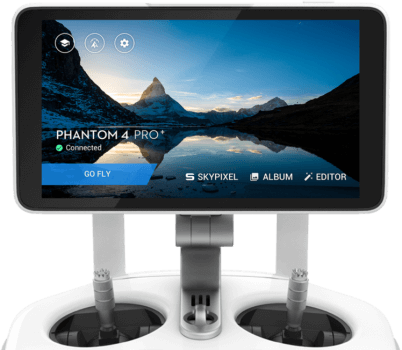
A 5.5in 1080p screen integrated with the Phantom 4 Pro + offers 1000 cd/m2 of brightness, more than twice as bright as conventional smart devices. It makes bright, vivid colors easily visible in direct sunlight. As the DJI GO 4 app is built into the screen, a mobile device is not required, simplifying pre-flight preparations. Integration of an HDMI port, Micro SD card slot, microphone, embedded loudspeaker, and Wi-Fi connection allow images to be edited inside DJI GO 4 to be shared almost instantly. Its five-hour battery life makes the Phantom 4 Pro + a complete aerial imaging solution.
INTELLIGENT FLIGHT - Draw
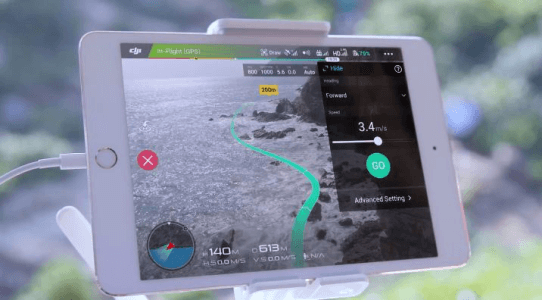
Draw is a brand new technology for waypoint control. Simply draw a route on screen and the Phantom 4 Pro will move in that direction while keeping its altitude locked. This allows the pilot to focus on camera control and enables more complex shots. There are two Draw modes that can be used in different scenarios.
Forward: The aircraft follows the route at a constant speed with the camera facing in the direction of flight.
Free: The aircraft only moves along the route when instructed. In this mode, the camera can face in any direction during a flight.
INTELLIGENT FLIGHT - Active Track

The Phantom 4 Pro automatically recognizes subjects, follows and captures them as they move, making it easier to get complex shots.
Following fast-moving objects can be very challenging, but advanced image recognition algorithms used by the Phantom 4 Pro allow it to recognize and track the object while keeping it in frame. This new algorithm also recognizes more subjects, from people to vehicles to animals, and will adjust its flight dynamics to match, ensuring smoother shots.
Pilots can now choose between:
Trace – Follow behind or in front of a subject, avoiding obstacles automatically.
Profile – Fly alongside a subject at a variety of angles to get profile shots of the subject.
Spotlight – Keep the camera trained on a subject while the aircraft flies almost anywhere.
INTELLIGENT FLIGHT - Tap Fly

Fly in any direction visible on-screen with a simple tap. Tap anywhere on-screen to smoothly adjust the direction of flight while automatically avoiding obstacles * and tap the screen again or use control sticks to change direction. A new AR route function shows the aircraft’s real-time flight direction for reference as its route is adjusted. As it can be difficult to control altitude, course, speed and camera pitch simultaneously using joysticks, TapFly Free allows a pilot to set the direction of flight, allowing them to turn the Phantom 4 Pro or tilt the gimbal as required without changing the direction of flight. In total, there are now three TapFly modes:
TapFly Forward – Tap to fly in the selected direction
TapFly Backward – Tap to fly in the opposite direction of the tap, i.e. tap in the bottom right corner of the screen to fly backward towards the top left.
TapFly Free – Lock the forward direction of the Phantom without locking the camera direction allowing it to turn as it flies.
*Obstacle Avoidance is not available with TapFly Free
INTELLIGENT FLIGHT - Return To Home

In its upgraded Return to Home mode, the Phantom 4 Pro can automatically choose the best route to return home depending on environmental conditions. It records its route as it flies, allowing it to return along the same route avoiding obstacles if the control signal is disconnected.
Based on its altitude at the time of disconnection, the Phantom 4 Pro is also able to adjust its flight path to avoid obstacles it has seen during its flight. At takeoff, the Phantom 4 Pro will record the scene below and compare its recording with what it sees as it returns, for more precise landing. It can also detect the ground to see whether there is suitable spot for landing. If any obstacles are found, or there is water on the ground, it will alert the pilot and hover at an appropriate height, helping the aircraft to land more safely.
INTELLIGENT FLIGHT - Gesture Mode
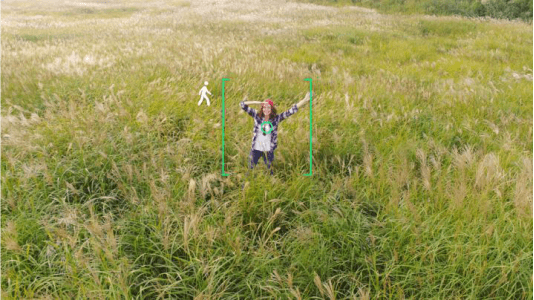
Using Gesture Mode, selfies can be captured easily using a few gestures without the remote controller. Advanced computer vision technology allows the Phantom 4 Pro to take instructions through gestures. The subject simply lifts their arms when facing the camera and the aircraft will recognize this movement by locking on and placing the subject in the center of the frame. When ready for a photo, the subject holds their arms out to signal the aircraft. A three second countdown will begin, making time to strike a pose, allowing moments to be captured without the remote control.
FLIGHT PERFORMANCE - Flight Modes

Different productions require different flight characteristics, and the Phantom 4 Pro offers three modes for flight: P, A and S. Switching between them allows pilots to get the control they need, whether they seek smoothness, simplicity, intelligent navigation or speed. In Position Mode, TapFly, ActiveTrack, obstacle sensing and positioning features are available. Sport Mode adds extra agility and higher speed, reaching 45mph (72kph). Atti Mode switches off satellite stabilization and holds the Phantom 4 Pro’s altitude. It is ideal for experienced pilots looking to capture smoother footage. Tripod Mode, which limits speed to 4mph (7kph) provides precision control for fine framing and indoor flying. Both the infrared sensing system and vision sensors are enabled in these modes for a safer flight experience.
FLIGHT PERFORMANCE - 4.3mi (7km) long-range control
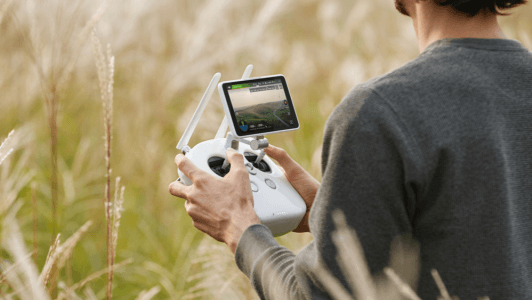
Using brand new DJI Lightbridge HD video transmission technology, the Phantom 4 Pro has a maximum transmission range of 4.3i (7km)*. Before each flight, it scans a range of available frequencies to find and use the one with the least interference. By supporting 2.4GHz and 5.8 GHz frequency bands, it gives you more reliable control. Tightly integrated with DJI GO 4, Lightbridge video transmission also sends vital flight statistics in real time, and can be used to quickly download photos and videos to connected mobile devices.
The Lightbridge video transmission system uses advanced transmission technologies and can automatically adjust to environmental conditions. It ensures high quality, low latency image transmission across its range and offers pilots a better shooting experience. Traditional analog video transmission occupies a larger bandwidth and is more susceptible to interference. It also suffers from poor image quality and short range. Wi-Fi transmission also compares poorly, suffering from low latency, lengthy re-connection times, and short transmission distances due to the high cost of more powerful Wi-Fi transmission.
* Unobstructed, free of interference, when FCC compliant.
FLIGHT PERFORMANCE - Sensor Redundancy
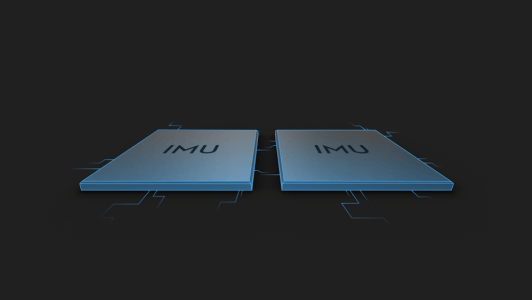
The Phantom 4 Pro features dual compass modules and dual IMU units, making it more reliable when compared to many hexacopters and octocopters. Compasses and IMUs are important sensors to ensure a stable flight and the Phantom 4 Pro constantly compares the data it receives through both pairs. This data is run through advanced algorithms to check accuracy and any inaccurate data is simply discarded without affecting flight, keeping flight steady and reliable.
FLIGHT PERFORMANCE - Intelligent Batteries

Professional aerial imaging benefits from longer flight times. The Phantom 4 Pro has a maximum flight time of 30 minutes, providing more time in the air to capture the perfect shot. The DJI GO 4 app shows battery lifetime and calculates remaining flight times according to the distance travelled and more. It will give alerts when it reaches a minimum safe amount required for a safe journey back to the takeoff point. An advanced battery management system is also in place to prevent overcharging and over draining. When placed in longer term storage, batteries will discharge power to maintain good health.
FLIGHT PERFORMANCE - DJI GO 4

When shooting aerials, the remote controller is responsible for most physical controls including piloting and capture. However, more challenging shoots require a real-time video feed, vital flight statistics and advanced settings. These are traditionally handled through a smart device, making the smart device essential to aerial imaging. The DJI GO 4 app is optimized for aerials and is updated along with the aircraft to ensure all features are supported. It can be used on smart devices and is available to be integrated into the DJI CrystalSky monitor, providing simple and convenient control.
Using the DJI GO 4 app, a large number of Intelligent Flight Modes are available. It also provides access to full manual camera controls, including ISO, aperture, shutter speed, image formats, and more. Any changes in DJI GO 4 will appear almost instantly on-screen. Vital flight data and video transmission status are easy to check in-app, further enhancing control efficiency and convenience.
DJI GO 4 includes editing features for quick editing and sharing to social media and even live streaming. After each flight, flight routes and data are automatically recorded and synchronized to the attached DJI GO 4 account, keeping it readily accessible for you to review. Both flight logs and data are easy to record and review.
PHANTOM COMPARISON
PHANTOM 4 PRO SPECS
AIRCRAFT
| Weight (Battery & Propellers Included) | 1388 g |
| Diagonal Size (Propellers Excluded) | 350 mm |
| Max Ascent Speed | S-mode: 6 m/s P-mode: 5 m/s |
| Max Descent Speed | S-mode: 4 m/s P-mode: 3 m/s |
| Max Speed | S-mode: 45 mph (72 kph) A-mode: 36 mph (58 kph) P-mode: 31 mph (50 kph) |
| Max Tilt Angle | S-mode: 42° A-mode: 35° P-mode: 25° |
| Max Angular Speed | S-mode: 250°/s A-mode: 150°/s |
| Max Service Ceiling Above Sea Level | 19685 feet (6000 m) |
| Max Wind Speed Resistance | 10 m/s |
| Max Flight Time | Approx. 30 minutes |
| Operating Temperature Range | 32° to 104°F (0° to 40°C) |
| Satellite Positioning Systems | GPS/GLONASS |
| Hover Accuracy Range | Vertical: ±0.1 m (with Vision Positioning) ±0.5 m (with GPS Positioning) Horizontal: ±0.3 m (with Vision Positioning) ±1.5 m (with GPS Positioning) |
VISION SYSTEM
| Vision System | Forward Vision System Backward Vision System Downward Vision System |
| Velocity Range | ≤31 mph (50 kph) at 6.6 ft (2 m) above ground |
| Altitude Range | 0 - 33 feet (0 - 10 m) |
| Operating Range | 0 - 33 feet (0 - 10 m) |
| Obstacle Sensory Range | 2 - 98 feet (0.7 - 30 m) |
| FOV | Forward: 60°(Horizontal), ±27°(Vertical) Backward: 60°(Horizontal), ±27°(Vertical) Downward: 70°(Front and Rear), 50°(Left and Right) |
| Measuring Frequency | Forward: 10 Hz Backward: 10 Hz Downward: 20 Hz |
| Operating Environment | Surface with clear pattern and adequate lighting (lux>15) |
CAMERA
| Sensor | 1’’ CMOS Effective pixels: 20M |
| Lens | FOV 84° 8.8 mm/24 mm (35 mm format equivalent) f/2.8 - f/11 auto focus at 1 m - ∞ |
| ISO Range | Video: 100 - 3200 (Auto) 100 - 6400 (Manual) Photo: 100 - 3200 (Auto) 100- 12800 (Manual) |
| Mechanical Shutter Speed | 8 - 1/2000 s |
| Electronic Shutter Speed | 8 - 1/8000 s |
| Image Size | 3:2 Aspect Ratio: 5472 × 3648 4:3 Aspect Ratio: 4864 × 3648 16:9 Aspect Ratio: 5472 × 3078 |
| PIV Image Size | 4096×2160(4096×2160 24/25/30/48/50p) 3840×2160(3840×2160 24/25/30/48/50/60p) 2720×1530(2720×1530 24/25/30/48/50/60p) 1920×1080(1920×1080 24/25/30/48/50/60/120p) 1280×720(1280×720 24/25/30/48/50/60/120p) |
| Still Photography Modes | Single Shot Burst Shooting: 3/5/7/10/14 frames Auto Exposure Bracketing (AEB): 3/5 bracketed frames at 0.7 EV Bias Interval: 2/3/5/7/10/15/20/30/60 s |
| Video Recording Modes | H.265 C4K:4096×2160 24/25/30p @100Mbps 4K:3840×2160 24/25/30p @100Mbps 2.7K:2720×1530 24/25/30p @65Mbps 2.7K:2720×1530 48/50/60p @80Mbps FHD:1920×1080 24/25/30p @50Mbps FHD:1920×1080 48/50/60p @65Mbps FHD:1920×1080 120p @100Mbps HD:1280×720 24/25/30p @25Mbps HD:1280×720 48/50/60p @35Mbps HD:1280×720 120p @60Mbps H.264 C4K:4096×2160 24/25/30/48/50/60p @100Mbps 4K:3840×2160 24/25/30/48/50/60p @100Mbps 2.7K:2720×1530 24/25/30p @80Mbps 2.7K:2720×1530 48/50/60p @100Mbps FHD:1920×1080 24/25/30p @60Mbps FHD:1920×1080 48/50/60 @80Mbps FHD:1920×1080 120p @100Mbps HD:1280×720 24/25/30p @30Mbps HD:1280×720 48/50/60p @45Mbps HD:1280×720 120p @80Mbps |
| Max Video Bitrate | 100 Mbps |
| Supported File Systems | FAT32 (≤32 GB); exFAT (>32 GB) |
| Photo | JPEG, DNG (RAW), JPEG + DNG |
| Video | MP4/MOV (AVC/H.264; HEVC/H.265) |
| Supported SD Cards | Micro SD Max Capacity: 128GB Write speed ≥15MB/s, Class 10 or UHS-1 rating required |
| Operating Temperature Range | 32° to 104°F (0° to 40°C) |
CHARGER
| Voltage | 17.4 V |
| Rated Power | 100 W |
APP / LIVE VIEW
| Mobile App | DJI GO 4 |
| Live View Working Frequency | 2.4 GHz ISM, 5.8 GHz ISM |
| Live View Quality | 720P @ 30fps |
| Latency | Phantom 4 Pro: 220 ms (depending on conditions and mobile device) Phantom 4 Pro +:160 - 180 ms |
| Required Operating Systems | iOS 9.0 or later Android 4.4.0 or later |




